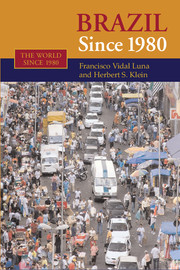Book contents
6 - Demographic Change in Brazil Since 1980
Published online by Cambridge University Press: 03 June 2010
Summary
As in most of Latin America by the middle of the twentieth century, Brazil was a predominantly rural society with high rates of mortality and fertility. The national population was young; a high ratio of infants died before their first year and a large number of children died before their fifth birthday, mostly from water-borne infectious diseases long reduced as killers in the industrial nations. Although a few large modern urban centers existed, the majority of the population lived in rural areas and they were ill-housed and lacked basic access to drinking water and sanitation. Most Brazilians did not have access to modern medical facilities. Brazil also was a nation not only divided between an advanced urban minority and a backward rural majority, but it was also profoundly divided by region, class, and race. The second most populous region was the poverty-stricken Northeast, which differed strikingly from the wealthier Central and Southern zones. The richer and better-educated members of the society tended to have the longest life expectancies and the best health, while whites in general did better than mulattos and they in turn did better than blacks.
In 1950, for example, only 36 percent of the population resided in cities, only 49 percent of adults 15 years of age and older were literate, and the average life expectancy of persons born in that year was only 45 years of age.
- Type
- Chapter
- Information
- Brazil since 1980 , pp. 158 - 181Publisher: Cambridge University PressPrint publication year: 2006

